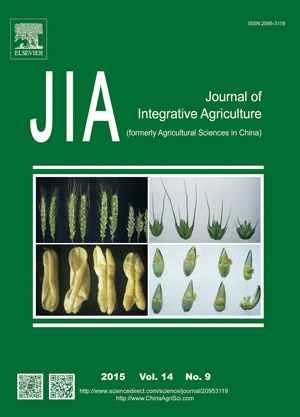|
|
Effect of nitrogen fertilization on yield, N content, and nitrogen fixation of alfalfa and smooth bromegrass grown alone or in mixture in greenhouse pots
XIE Kai-yun, LI Xiang-lin, HE Feng, ZHANG Ying-jun, WAN Li-qiang, David B Hannaway, WANG Dong, QIN Yan, Gamal M A Fadul
2015, 14(9):
1864-1876.
DOI: 10.1016/S2095-3119(15)61150-9
Planting grass and legume mixtures on improved grasslands has the potential advantage of realizing both higher yields and lower environmental pollution by optimizing the balance between applied N fertilizer and the natural process of legume biological nitrogen fixation. However, the optimal level of N fertilization for grass-legume mixtures, to obtain the highest yield, quality, and contribution of N2 fixation, varies with species. A greenhouse pot experiment was conducted to study the temporal dynamics of N2 fixation of alfalfa (Medicago sativa L.) grown alone and in mixture with smooth bromegrass (Bromus inermis Leyss.) in response to the addition of fertilizer N. Three levels of N (0, 75, and 150 kg ha–1) were examined using 15N-labeled urea to evaluate N2 fixation via the 15N isotope dilution method. Treatments were designated N0 (0.001 g per pot), N75 (1.07 g per pot) and N150 (2.14 g per pot). Alfalfa grown alone did not benefit from the addition of fertilizer N; dry matter was not significantly increased. In contrast, dry weight and N content of smooth bromegrass grown alone was increased significantly by N application. When grown as a mixture, smooth bromegrass biomass was increased significantly by N application, resulted in a decrease in alfalfa biomass. In addition, individual alfalfa plant dry weight (shoots+roots) was significantly lower in the mixture than when grown alone at all N levels. Smooth bromegrass shoot and root dry weight were significantly higher when grown with alfalfa than when grown alone, regardless of N application level. When grown alone, alfalfa’s N2 fixation was reduced with N fertilization (R2=0.9376, P=0.0057). When grown in a mixture with smooth bromegrass, with 75 kg ha–1 of N fertilizer, the percentage of atmospheric N2 fixation contribution to total N in alfalfa (%Ndfa) had a maximum of 84.07 and 83.05% in the 2nd and 3rd harvests, respectively. Total 3-harvest %Ndfa was higher when alfalfa was grown in a mixture than when grown alone (shoots: |t|=3.39, P=0.0096; root: |t|=3.57, P=0.0073). We believe this was due to smooth bromegrass being better able to absorb available soil N (due to its fibrous root system), resulting in lower soil N availability and allowing alfalfa to develop an effective N2 fixing symbiosis prior to the 1st harvest. Once soil N levels were depleted, alfalfa was able to fix N2, resulting in the majority of its tissue N being derived from biological nitrogen fixation (BNF) in the 2nd and 3rd harvests. When grown in a mixture, with added N, alfalfa established an effective symbiosis earlier than when grown alone; in monoculture BNF did not contribute a significant portion of plant N in the N75 and N150 treatments, whereas in the mixture, BNF contributed 17.90 and 16.28% for these treatments respectively. Alfalfa has a higher BNF efficiency when grown in a mixture, initiating BNF earlier, and having higher N2 fixation due to less inhibition by soil-available N. For the greatest N-use-efficiency and sustainable production, grass-legume mixtures are recommended for improving grasslands, using a moderate amount of N fertilizer (75 kg N ha–1) to provide optimum benefits.
|
